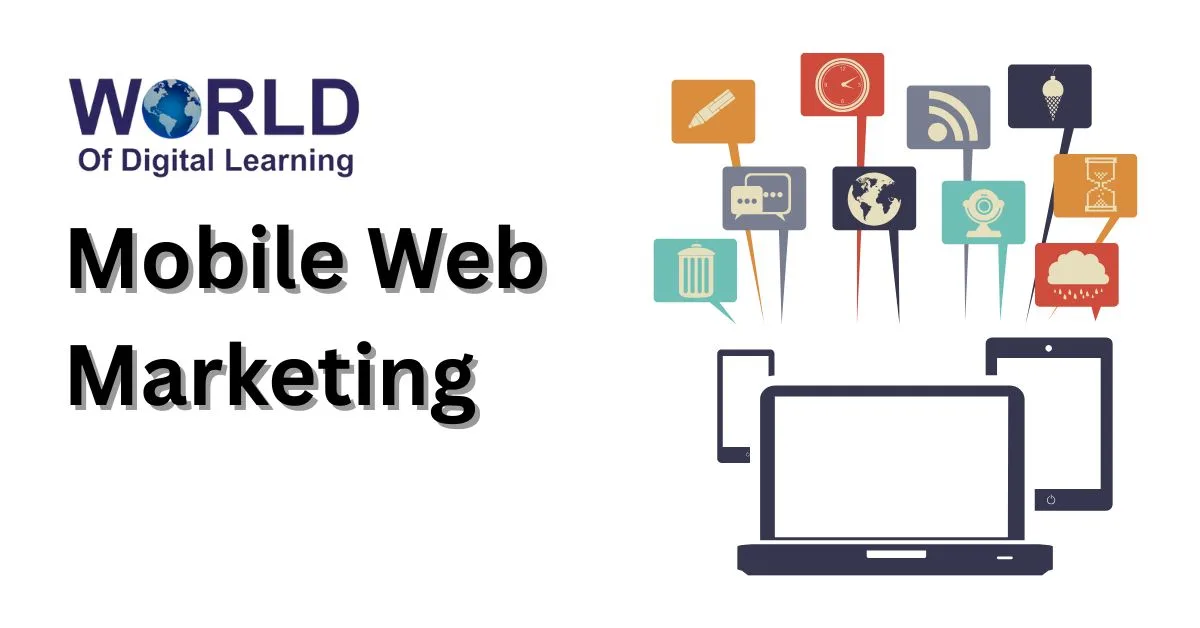Mobile web marketing is a digital marketing strategy that targets consumers through their mobile devices, such as smartphones and tablets. With increasing mobile usage, having a mobile-friendly website and content is essential to reach and engage users effectively. This approach includes optimizing website design for smaller screens, faster loading times, and easy navigation. Mobile web marketing also involves SMS and MMS promotions, app-based advertising, push notifications, location-based targeting, and social media marketing tailored for mobile platforms. The goal is to provide a seamless, personalized experience to users wherever they are, encouraging engagement and conversions. Because mobile users often browse quickly, content must be clear, concise, and visually appealing. Integrating mobile marketing with other channels ensures consistent messaging, strengthening brand presence and customer loyalty. By leveraging the unique capabilities of mobile technology, businesses can connect with their audience more directly and effectively than ever before.
Table of Contents
How to Creation through 3rd Party Platforms
Creating content through third-party platforms means using external tools and services to help plan, produce, and share your digital content effectively. Platforms like Canva and Adobe Spark make designing visuals easy with ready-made templates, while influencer marketing platforms like IndaHash and Impact.com connect brands with content creators to create authentic, engaging stories. These platforms often offer collaboration tools, content libraries, and analytics to streamline the creation process and monitor performance. You can also use video-sharing sites, podcast platforms, and social media schedulers to distribute content widely and engage audiences. By leveraging third-party platforms, brands save time, enhance creativity, and ensure their messaging reaches the right people. It also allows for professional-quality content without needing large in-house teams, making it an accessible and efficient way to grow brand presence online. Guerrilla marketing is a creative and unconventional way of promoting a product, service, or brand by grabbing attention in unexpected places. Instead of spending huge amounts on traditional ads, businesses use surprising tactics to create a strong impression with fewer resources. It could be something like eye-catching street art, a flash mob, a clever sticker campaign, or a fun stunt that makes people talk about it. The idea is to connect with the audience emotionally and make the brand memorable. Guerrilla marketing often spreads through word of mouth or social media, giving it a bigger reach without a big budget. It works best when it’s original, surprising, and aligned with the target audience’s lifestyle. Small businesses and startups especially benefit from this approach because it allows them to compete creatively with big brands. In short, it’s about marketing smartly, not expensively, by using imagination and surprise to leave a lasting impact.
How to Upload an App on Google Play Store
To upload an app to the Google Play Store, start by creating a Google Play Developer account, which requires a one-time $25 registration fee. Next, go to the Google Play Console and select “Create app.” Choose a default language, name your app, and specify if it is an app or game, free or paid. Then provide contact details and agree to the developer program policies. After creating the app, fill in important details such as app description, screenshots, category, content rating, and privacy policy URL. Upload your app file in APK or AAB format, and choose your release type—production for full launch, or beta/alpha for testing. Before publishing, test your app thoroughly on multiple devices for performance and bugs. Finally, submit your app for review, and once approved, it will be available for millions of users to download from the Play Store. Regular updates and user support keep your app relevant and trusted.
Mobile app marketing strategies
Mobile app marketing strategies focus on boosting app downloads, user engagement, and retention through a multi-channel approach. Optimizing your app store listing with relevant keywords, clear descriptions, and attractive visuals (App Store Optimization or ASO) increases visibility and conversion rates. Paid ads targeting specific demographics on social media, search engines, and video platforms help reach potential users effectively. Creating viral loops, like referral programs or shareable in-app milestones, encourages word-of-mouth growth. Personalizing user experiences through push notifications and in-app messages boosts engagement and retention. Testing different ad creatives, messaging, and targeting ensures efficient use of marketing budgets. Additionally, leveraging analytics and AI-powered tools provides insights into user behavior, allowing continuous optimization. Combining organic methods like content marketing and influencer collaborations with paid campaigns creates a balanced strategy that drives sustainable app growth in today’s competitive market.
Increasing Mobile App Downloads
Increasing mobile app downloads requires a combination of strategies that boost visibility and appeal. Start by optimizing your app store listing with clear descriptions, relevant keywords, and eye-catching visuals like icons and screenshots to grab attention instantly. Leverage social media to share engaging content and testimonials, and consider influencer collaborations to reach broader audiences authentically. Running targeted paid ads helps attract potential users who match your demographics. Encourage positive user reviews and ratings—they build trust and improve ranking in app stores. Localization is powerful; adapting your app and store listing to different languages and regions can significantly increase downloads. Use referral programs and incentives to motivate current users to invite friends. Lastly, track your marketing efforts using analytics to understand which strategies work best and refine your approach constantly. These steps together help create a strong presence and steady growth in app downloads. Mobile app marketing strategies focus on boosting app downloads, user engagement, and retention through a multi-channel approach. Optimizing your app store listing with relevant keywords, clear descriptions, and attractive visuals (App Store Optimization or ASO) increases visibility and conversion rates. Paid ads targeting specific demographics on social media, search engines, and video platforms help reach potential users effectively. Creating viral loops, like referral programs or shareable in-app milestones, encourages word-of-mouth growth. Personalizing user experiences through push notifications and in-app messages boosts engagement and retention. Testing different ad creatives, messaging, and targeting ensures efficient use of marketing budgets. Additionally, leveraging analytics and AI-powered tools provides insights into user behavior, allowing continuous optimization. Combining organic methods like content marketing and influencer collaborations with paid campaigns creates a balanced strategy that drives sustainable app growth in today’s competitive market.
Mobile App SEO
Mobile app SEO, also known as App Store Optimization (ASO), is the process of improving an app’s visibility and ranking within app stores like Google Play and the Apple App Store. Effective mobile app SEO starts with thorough keyword research to identify terms that potential users are searching for. These keywords should be incorporated naturally into the app’s title, subtitle, and description. Visual elements such as eye-catching icons, high-quality screenshots, and engaging preview videos also play a crucial role in attracting users and increasing downloads. Choosing the right category and localizing content for different markets enhances discoverability. Encouraging positive reviews and promptly responding to user feedback boosts the app’s reputation and ranking. Routine updates improve functionality and signal to stores that the app is active, while A/B testing elements like screenshots and descriptions help identify what resonates best with users. Mobile app SEO is essential for driving organic downloads and long-term app success.
Leads Generation Through Mobile App Campaigns
Lead generation through mobile app campaigns involves attracting and converting potential users directly from their mobile devices by using targeted, engaging strategies. Successful campaigns often begin with creating mobile-friendly opt-in forms and pop-ups that collect contact information with minimal friction. Using push notifications and in-app messaging personalizes communication, encouraging users to take desired actions such as signing up or making a purchase. Leveraging social media ads targeted specifically at mobile users increases awareness and drives app installs. Offering incentives like discounts or exclusive content motivates users to provide their details. Referral programs encourage existing users to invite friends, expanding reach organically. Additionally, integrating analytics tools helps track user behavior, enabling continuous improvement of campaign effectiveness. Mobile optimization, including fast-loading pages and clear call-to-action buttons, ensures a smooth user experience, which is critical for converting interest into qualified leads. These strategies together turn mobile app users into loyal customers, driving business growth efficiently. Mobile app campaigns generate leads by engaging users directly through their smartphones with targeted and optimized strategies. Key tactics include creating mobile-friendly opt-in forms and pop-ups that are easy to fill out on small screens, capturing essential user information like email or phone number. Push notifications and in-app messages personalize communication, prompting users to take action such as signing up or purchasing. Social media advertising directed at mobile users boosts app visibility and downloads. Offering incentives and referral programs encourages users to share the app, expanding reach organically. Additionally, analytics tools track user behavior, allowing continuous refinement of campaigns for better conversion rates. Ensuring fast, seamless mobile experiences with clear calls-to-action improves user engagement and captures more qualified leads. Leveraging these mobile-focused strategies effectively turns app users into loyal customers and drives sustainable business growth.
Tracking Mobile Conversions
Tracking mobile conversions involves monitoring how users complete specific actions within a mobile app, such as installs, purchases, sign-ups, or any other goal that indicates successful engagement. Using tools like Google Ads conversion tracking, Firebase, or third-party analytics platforms, marketers can measure the effectiveness of their campaigns by linking ad clicks or other efforts to these valuable user behaviors. Effective tracking captures both macro conversions (major actions like purchases) and micro conversions (smaller steps like adding items to a cart or signing up), providing a complete picture of the user journey. Analyzing key metrics such as conversion count, conversion rate, and average time to convert helps identify where users drop off and what drives success. Advanced tracking methods, including server-side tracking and cross-device attribution, improve accuracy and insights. This data enables marketers to optimize campaigns, allocate budgets wisely, and enhance user experience for better results.

 October 3, 2025
October 3, 2025  9 Min
9 Min  No Comment
No Comment 